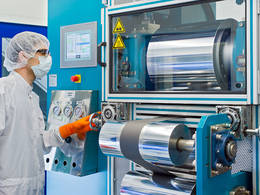The downside to solar and wind is not just low efficiency and high cost, it is also that they are intermittent. But that impacts cost also. Relying on them has meant contracting with traditional energy companies to be 'on demand' at far higher cost than they otherwise would be, to be on call to shut off or add electricity as needed.
Wind will never be a serious alternative but solar is the future. Yet no matter how good solar becomes, there will still be a problem of storage and riding out its fluctuations - and existing storage capacities are far from adequate for the purpose.
While Americans squandered tens of billions of dollars on trying to undersell Chinese solar panels, Asian companies have been addressing the real need - modern battery systems.
When will they be available? Companies that aren't relying on political favors don't readily divulge their R&D activities, but worldwide patent applications relating to electrochemical energy storage between 1991 and 2011 can provide an idea how far out these products are.

Scientists at TUM research new ways to produce lithium-ion-batteries. (Photo: Heddergott/TUM
A paper by economists at Technische Universitaet Muenchen
have analyzed the annual number of new patent families, i.e. groups of patent applications and patents for similar or equivalent inventions (e.g. applications in different countries) and finds they rose by 110 per cent from 2006 to 2011. In 2006, applications for intellectual property rights for around 2,800 developments were submitted.
In 2011, the figure had already increased to 5,900 applications. "In view of these investments, we can assume that new electrochemical energy storage technologies will be ready for market entry in the near future and will be more cost-effective than the existing products," says Simon C. Müller, physicist and economist, at the chair for Strategy and Organization.
The lithium segment
It may not be all good news. The most patent applications by far were filed by developers of lithium batteries, which means people are still evolving decades-old technology rather than creating new science. In 2011, there were 4,900 new patent families. Indeed, the curve for application numbers in this segment follows a steep upward trend since 2008, after a single dip in 2007.
Before that, several suppliers had had to take back products due to safety issues.
"Apparently, fears that lithium batteries cannot be made safe enough have vanished," says Müller. Moreover, the new patent applications are cited more often than other technologies by newer patent families - a mark of quality which shows that they play a role in the continued development of the technology.
In second place in terms of the number of patent applications filed are lead batteries with only around 580 new patent families in 2011. The scientists noted, however, a recent marked increase, albeit to a low level, for redox flow batteries, in which the energy-storing chemical compounds are used in liquid form: From 2009 until 2011, the number of applications more than doubled from 90 to 200.
The number of new patent families for alkaline batteries dropped slightly to 240 and sodium-sulphur technologies played a consistently marginal roll with 20 applications.
"The lithium segment is very dynamic," says Müller. "Quite possibly, we will soon reach a point at which a self-multiplying effect can be seen. As soon as the techno-economic data are good enough, research and development activities will attract more investments, which will generate an even stronger lead."
The fact that lithium batteries are also used in electric cars will only contribute to this development, since batteries will be in demand both in the energy sector and in the automotive industry.
Europe's best company is ranked 25th and Asia outdoes the Continent by 4X
The analysis indicates that Asian companies will dominate the market. In 2011, 2,100 applications for patent families relating to electrochemical energy storage could be attributed to Asian developers; 530 to European, and only 410 to US developers.
Despite a high initial figure in 2001, the Asians were thus able to increase their applications by 220 percent; European applications rose by 260 percent and US applications by 70 percent.
If one considers the quality of the portfolio, Asian companies still hold a very dominant position. The scientists used an index that takes both quantitative data and the number of application citations into consideration.
According to this index, the top 10 in the lithium batteries segment include eight Japanese and one Korean company, with Fuji in the lead. Only one US company, Valence Technology, is found here. The most successful European institution, Centre National de la Recherche Scientifique (CNRS), is only ranked 25th.
"These results raise interesting questions about research policy and development management. Further studies could, for instance, look at which strategies have given certain companies a technological lead in this field, and which lessons may be learned from this by European and US competitors," says Prof. Isabell M. Welpe, who holds the Chair for Strategy and Organization.





Comments